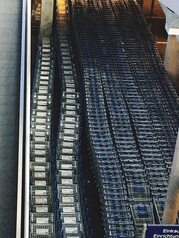Connectivity and Quality of Life: A Boost to Added Value

Connectivity has become a key factor in enhancing quality of life and, in turn, increasing property value. In a world where technology and access to services are essential, well-connected homes not only provide comfort but also represent a smart investment. This article explores how a strategically connected location can transform your lifestyle and boost the value of your property in the competitive Costa Rican real estate market.
The importance of road infrastructure in Costa Rica
The road infrastructure in Costa Rica plays a fundamental role in the connectivity of communities and in the economic development of the country. An efficient road system not only facilitates the transportation of people but also optimizes logistics for businesses, resulting in sustained growth and attracting investments. When the roads are adequate and well-maintained, travel becomes faster and safer, benefiting those living in peripheral areas who wish to access urban services. This reality reinforces the idea that good road infrastructure can significantly increase the value of properties located in areas with easy access.
Additionally, the quality of the roads directly influences the lifestyle of the citizens. Better connectivity allows residents to enjoy a wider range of recreational, educational, and job options, which is essential for improving their quality of life. For example, those living near main routes have easier access to educational centers and hospitals, which not only enhances their personal well-being but also makes their homes more attractive to future buyers or tenants. In this sense, investing in areas with good road infrastructure becomes a strategic decision for both owners and real estate developers interested in maximizing the long-term value of their investments.
2. Digital connectivity: Beyond fast internet
Digital connectivity goes beyond simply having access to fast internet; it involves a seamless integration of devices and services that enhance daily life at home. From home automation systems that allow control of lighting, temperature, and security from a smartphone, to remote work platforms that facilitate collaboration among teams, every aspect of our lives is influenced by this interconnection. These technological advancements not only provide convenience but also enable residents to optimize their time and resources, which is especially valuable in urban environments where every minute counts.
Moreover, digital connectivity facilitates access to a range of essential services such as online education, remote healthcare, and entertainment platforms. This wide variety of options not only improves quality of life by offering convenience and flexibility but also increases the appeal of the home for potential buyers or renters. In this sense, properties located in areas with high digital connectivity are seen as more desirable investments in the real estate market, elevating their value by aligning with the modern needs of residents. The ability to enjoy a fulfilling and connected life not only transforms the home; it also redefines its value in a broader context.
3. Urban vs. rural areas: Where is the best appreciation?
Urban areas have traditionally been the epicenter of development and real estate investment. With more advanced transportation infrastructure, access to essential services, and a greater variety of cultural and entertainment options, cities often offer an unmatched appeal for those seeking quality of life. However, this high demand can also lead to elevated prices, which may limit opportunities for some buyers. Appreciation in urban areas tends to be more dynamic due to the constant renewal and expansion of projects that enhance connectivity, but it is crucial to assess whether the associated costs are justified by the perceived benefits. On the other hand, rural areas are experiencing a resurgence due to the search for a quieter and more sustainable lifestyle. As technology advances and improves connectivity options in these areas, more people are considering moving to the countryside without giving up modern conveniences. Rural properties can offer attractive appreciation due to their lower initial price and growth potential, especially in places where infrastructure like roads or utilities is being developed. Thus, choosing between an urban or rural area not only affects immediate lifestyle but is also essential for projecting the future value of a property in an increasingly competitive real estate market.
4. Nearby services: How do they influence your quality of life?
Nearby services, such as schools, hospitals, supermarkets, and entertainment centers, play a fundamental role in the quality of life of residents. Living in an area where these services are easily accessible not only saves time and reduces daily stress but also encourages greater social and community interaction. The presence of these establishments creates a more dynamic and attractive environment for families, which in turn can lead to a higher demand for properties in that area. Thus, connectivity with essential services becomes a key indicator for those seeking a home that facilitates their daily life.
Additionally, proximity to quality services can directly influence the perceived value of a property. Buyers tend to place a higher value on homes that are located near good schools or recognized medical centers, as this implies a secure investment for both their well-being and the economic future of the property. This trend results in higher prices and sustained appreciation over time. Therefore, choosing a home in a well-served location not only enhances your immediate quality of life but also ensures better long-term profitability when it comes time to sell or rent the property.
5. Efficient public transportation: Key to a good location
Efficient public transportation is a fundamental pillar for defining the quality of life in a community and, therefore, its appeal in the real estate market. When people have access to a transportation system that allows them to move easily and quickly, commute times are minimized and stress levels associated with daily traffic are reduced. This not only improves the user experience but also encourages a more active and healthy lifestyle, as it facilitates access to recreational areas, educational centers, and workplaces without relying solely on private vehicles.
Additionally, a good public transportation network can be a determining factor in the appreciation of properties located nearby. Well-connected areas tend to attract both tenants and buyers interested in enjoying the convenience of easy access to various routes and services. The perception of safety and efficiency in transit can significantly increase the interest in living in those places, which directly results in an increase in real estate value. Thus, investing in properties close to train stations or bus stops not only represents a logical decision for those seeking quality of life but also a smart strategy to capitalize on market growth.
6. Future projects that will enhance connectivity in the country
The future projects being developed in the country have the potential to radically transform connectivity and, therefore, the quality of life of its inhabitants. Initiatives such as the expansion of efficient public transport networks, the construction of new road routes, and the improvement of digital infrastructure are just a few examples that will contribute to a more connected environment. These improvements will not only facilitate daily commuting but also enhance access to essential services, fostering more balanced development among the different regions of the country. The interconnection between urban and rural areas will promote inclusive growth that will benefit all citizens.
Additionally, innovative technology projects are being planned that will enable greater digital integration. The implementation of 5G networks and the development of smart platforms to manage public services are steps toward a future where connectivity will be ubiquitous. These advancements will not only optimize the everyday home experience—ranging from telecommuting to home automation systems—but will also significantly increase the appeal of properties located in areas with these technological advantages. Consequently, investors attentive to these trends will have valuable opportunities to enhance the appreciation of their real estate, ensuring a smart long-term investment.
7. The relationship between security and connectivity in emerging neighborhoods.
Safety and connectivity are two fundamental pillars in the development of emerging neighborhoods. As communities modernize, the implementation of advanced technologies and efficient communication systems not only improves the quality of life but also directly influences the perception of safety among residents. A well-connected environment allows residents to quickly access essential services, such as healthcare and education, as well as communication tools that facilitate community collaboration and foster a sense of belonging. This strengthening of the social fabric is crucial for establishing a safe environment where families can thrive.
Additionally, good connectivity infrastructure can be a deterrent to crime. Neighborhoods with reliable internet networks and access to connected surveillance cameras tend to experience a decrease in crime, as they become less attractive for illicit activities. The interplay between security and technology creates a positive cycle: by enhancing security through technological solutions, the area's appeal to new residents and investors increases. Thus, these emerging neighborhoods not only raise their property value due to their connectivity but also build a strong reputation as safe and desirable places to live.
8. Testimonials from owners: The real impact of connectivity
The testimonies of owners who have experienced the impact of connectivity in their lives are revealing. Many highlight how a good internet connection and proximity to essential services, such as stores, schools, and public transportation, have allowed them to optimize their time and improve their quality of life. For example, families with young children mention that having quick access to educational centers and recreational areas has facilitated parenting and fostered a healthier environment for their children's development. Additionally, professionals who work from home emphasize how a stable connection enables them to be more productive, which translates into a better work-life balance.
Another notable aspect is the increase in the perception of value of well-connected properties. Owners who chose to invest in homes strategically located near main roads or commercial areas report that this has not only improved their daily experience but has also enhanced the resale value of their properties. In a market where more and more buyers prioritize connectivity as an essential factor, these testimonials underscore the importance of considering this element when purchasing a property. The conclusion is clear: investing in a home with good connectivity not only improves current quality of life but also represents a smart financial decision for the future.
9. Strategies for choosing locations with high appreciation potential
When considering the purchase of a property, it is essential to identify locations that offer high potential for appreciation. An effective strategy is to analyze the development of infrastructure in the area, such as new access roads, public transport, and basic services. The arrival of new bus routes or the construction of roads can transform a previously unattractive area into a hotspot for buyers and investors. Furthermore, observing the urban planning of the municipality can provide clues about future investments in the area, which will positively influence property values.
Another key aspect to consider is the demographic and socioeconomic dynamics of the area. Areas experiencing population growth, especially those attracting young professionals and families, tend to see a notable increase in their property values. Assessing proximity to recognized educational institutions, hospitals, and recreational spaces can be decisive; these elements not only enhance the appeal for future residents but can also stabilize the local real estate market. Ultimately, choosing a location with good prospects for future development ensures not only a better quality of life today but also a solid investment for tomorrow.



